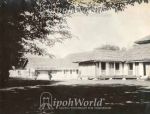We've tried to ensure the information displayed here is as accurate as possible. Should there be any inaccuracies, we would be grateful if you could let us know at info@ipohworld.org . All images and content are copyright.
(Please click on the thumbnail for a bigger image.)
The First Ipoh Club Buildings, Mr A Oldfield And The Club's History

This photograph is courtesy of late Dato Harry Gilo, who donated it to the Ipoh Club and dated it 1904. The centre building is probably the 1893 'attap and timber affair' referred to below which was at the junction of Hugh Low Street and Club Road and the very first of the Club buildings. The other buildings in this picture would have been built around 1900, before the club was completely rebuilt at its present site (see below).
The plans for forming the Ipoh Club were conceived at the Oldfield's Dispensary in 1892 by a small group of Europeans who had got into the habit of dropping in to the dispensary around noon and partaking of a glass or two from their personal bottle of Scotch Whisky secreted behind the medicine bottles. This was generally diluted with a little Soda Water sold to them by Oldfield.
Mr A Oldfield was one of the earliest European residents in Ipoh and the town's first chemist. He had arrived here before the introduction of the railway and always wore a white suit. He was known by the locals as Tuan Lima Kupang, Fifty cents for that was what he charged for anything he dispensed to his customers. He sold his business in 1905 to Messrs Graham & Co of Penang who then formed a new company, Oldfields Dispensaries Ltd. It was this compant that later moved into the Chung Thye Phin building in Belfield Street.
This small “drinking club’, it could be argued, was the original Ipoh Club, formed in 1892 (rather than 1895 as shown on the Club’s website) without a clubhouse.
The first building for the club was put up in 1893 at the junction of Hugh Low Street and Club Road and described at the time as 'an attap and timber affair'. Because of its drab and less than imposing appearance the Club was called by its members ‘The Dun Cow’, Dun meaning grayish brown, but the name never really stuck. We believe the single storey central building pictured above is of the Dun Cow, but we may be wrong.
Later, the Club moved its premises to the present location in front of Ipoh Padang, facing south. This was and still is, a much more imposing building. Of course, in the early days the membership was exclusively white and attendance was almost entirely male except for occasions like the regular ‘smoking concerts’ and dances.
The club premises included a bar, billiards, cards, reading, bath and dressing rooms. All purchases were signed for on the ‘chit’ system with members settling their bills monthly, but there were occasions that the debts had risen to such a level that the bar had to be closed. That soon brought in the outstanding bills!
The seven and a half acres of recreation ground was used for football, cricket, tennis and croquet. Besides that, the club also had a theatre hall, which was frequently used by the Kinta Amateur Dramatic Club for concerts and performances.
In 1985 the Sultan of Perak, Sultan Azlan Shah, graciously awarded the club the title of The Royal Ipoh Club to celebrate what the committee of the club then believed was the centenary of its formation. However there is plenty of evidence to confirm the earlier date of 1892 as stated above.
We are grateful to Dr Ho Tak Ming of Ipoh for this information.
To see a tinted postcard of this same picture, click here.
To read more about Chung Thye Phin click here.